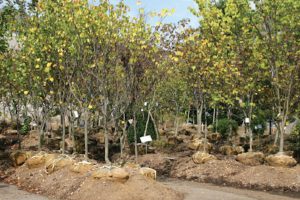Fall months still offer a great time for tree planting
Chronicle Media — September 29, 2017Fall is a great time to plant trees, even with our drier than usual weather pattern. Proper and frequent watering will be even more critical to the process this year, but homeowners also should take note of some small, but important, steps along the way.
“Northern Illinois is still working to replace ash trees lost due to Emerald Ash Borer, and autumn is the best time to put in any new trees,” said Richard Hentschel, Horticulture Educator for University of Illinois Extension, serving DuPage, Kane and Kendall counties. “There are many other species of trees to choose from. It is important to consider where the new tree will be planted, and how big of a tree is wanted when it is mature.”
Once size, location and plant characteristics have been decided, the decision of planting the tree yourself or having the tree planted by the nursery must be made.
“How much the tree weighs is often the deciding factor for a homeowner,” Hentschel said. “Trees can be found in large pots with an artificial soil and weigh far less than the same tree offered as a balled and burlapped tree.”
Hentschel pointed out that one limitation to a potted tree will be the sizes available. “If you are looking to replant with a larger tree, then you will most often go with a balled and burlapped plant,” he said.
How you plant the tree will make a big difference on how quickly it recovers and to its long-term health. The real challenge will be making sure the pot or ball is planted at the right depth in your yard.
“Regardless of how the tree sits in the pot or what it looks like being balled in burlap, there is a critical spot on the trunk that should be found before digging the hole,” said Hentschel.
This “spot” is the flare area where the trunk begins to turn into the root system. On larger trees, this flare is more readily apparent.
On smaller trees, you will have to clear away the soil in the pot or the top of the ball to be sure you know where this flare is. Even on a larger, balled and burlapped tree the flare can be below the top of the ball.

University of Illinois Extension Horticulture Educator Richard Hentschel says fall is a perfect time to plant while paying attention to the size, location and specifics to each variety. (Photo courtesy of University of Illinois Extension)
“What research has shown us is that a tree planted too deep is slow to recover from being transplanted and has more problems in the future with insects and disease,” Hentschel noted. “Once you have determined where the flare is, the hole should be dug so the flare will be at the soil line or even an inch or two above that.”
If there is not great drainage, then above the soil line is suggested. Roots will naturally grow down into the soil profile to a depth where they find a balance of soil moisture and air for quickest transplant recovery and long-term growth, said Hentschel.
“Once you are ready to set the tree in the planting hole, there are a few more things that can ensure that the tree will establish easily,” he said. “For a tree that has been grown in a pot, there will be some roots that have found the edge of the pot and are now circling. These roots need to be bent outward as you backfill the hole. If they cannot be bent out, pruning them away is the alternative. Any new roots that grow from the cut will grow out normally.”
For balled and burlapped plants, Hentschel recommends a different strategy once the ball is in the planting hole.
“Those elements may not be entirely natural and rot away as in the past, so twine will need to be removed from around the base of the trunk and burlap down over the sides of the ball as far as possible.”
He added that any wire basket also should be removed down over the shoulder of the ball, leaving room for the expanding roots to develop.
“You can use the remaining portions of the wire basket to tie more twine up and over the ball, just not around the trunk in order to help stabilize the tree in the new hole.”
The final planting steps will be to backfill with the soil about two-thirds up, then water to settle the soil around the root ball. Finish backfilling with soil and water to settle that soil as well.
“With any remaining soil, you can create a berm for watering the rest of the fall. The berm will retain the water and keep it where the roots are, right in the area of the ball or pot,” Hentschel said. “You’re not done though. It is crucial to monitor at least once a week and water as needed right up until about mid-November.”
If water is needed, Hentschel said to apply enough water to soak the root ball or pot ball. Also, before freezing temperatures arrive, he suggests cutting a couple of spots out of the watering berm so it will not stand water and harm the tree trunk.
“When you water your newly planted trees, go ahead and do a lap around the yard,” said Hentschel. “Given the drier weather this fall, give trees, shrubs, and perennials attention over the next few months, especially any new plants added this year. You can do this right up until the time we are putting away the hoses for the winter or until natural rains return.”
For more information on University of Illinois Extension programs and services in DuPage, Kane or Kendall County, visit go.illinois.edu/extensiondkk.
— Fall months still offer a great time for tree planting —-








